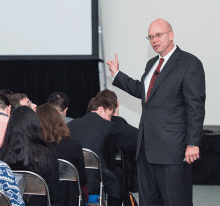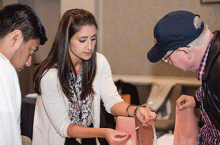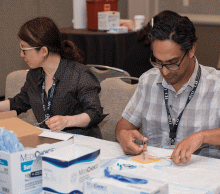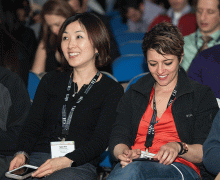User login
SAN DIEGO — If you arrived late, or even right on time, to the session on becoming a better attending, you’d better have been ready to find a clear spot on the floor or have had the energy to stand for an hour.
Read more about the speakers at HM16.
But the dynamic talk, you could even say performance, by Jeffrey Wiese, MD, MHM, crackled with energy, so there was plenty of it to go around. The session, in its 10th year and now practically an institution of its own at the annual meeting, was a highlight among the offerings on career development at HM16.
Dr. Wiese liberally seasoned the session with role-playing and humor—the “patient” on the session-room floor but without a pillow meant “Press Ganey’s going to take a hit on this one,” he joked. He emphasized the importance of attending physicians to give reasons to support the expectations they have for their trainees.
“The key piece is giving that rationale. Once they have a reason for why they’re going to do it, now the expectation’s grounded, now it actually makes sense,” said Dr. Wiese, professor of medicine at Tulane University Health Sciences Center in New Orleans and a past SHM president. “You don’t do that, they’re going to fill in the gaps with their own expectations.”
Other points of emphasis:
- The importance of autonomy and choice so that trainees have a sense of purpose;
- The transition from self-interested medical students to residents who are concerned with the well-being of team members;
- The assurance of an endpoint so that hectic periods don’t spiral out of control; and
- Acts of ritual, such as using Purell before entering a patient’s room, as moments of “genuflect” to regain perspective.
Charles Kast, MD, an attending physician at Long Island Jewish Medical Center in New Hyde Park, N.Y., said the relationship theme resonated with him the most.
“It’s more the relationships the attendings have with their residents and with their students, and it’s more of an emotional connection,” he said. “Whether it’s education or mentoring or what have you, it’s all about developing that trust between the resident and the attending.”
But it’s a gradual process.
“It’s baby steps,” Dr. Kast added. “There were 17 different lists in there, right? So you’ve got to pick one and kind of go with it. I think it’s kind of an organic process, where one thing kind of leads to the next.”
Tactics to avoid burnout—by cultivating a sense of purpose while understanding and relating to trainees’ concerns—were a key part of Dr. Wiese’s message. Burnout was a topic that HM16 attendees returned to again and again when discussing their take-homes from the meeting. The subject popped up in almost every session to one degree or another.
David Nevin, MD, a hospitalist at ThedaCare in Wisconsin, said that he was reminded in one session—“Staying in the Game: Self-Care for Hospitalists”—that taking even brief moments for yourself can make a difference.
“Focusing on the positive for a moment and what’s good about your life, and doing that kind of exercise, helps sort of deal with burnout and bring things into perspective,” he said. “You get sort of worn down, you’re not as sharp, you miss things when you’re not at your peak in terms of looking at things.”
Ariana Peters, DO, who works at Mayo Clinic in Scottsdale, Ariz., said a similar message resonated with her, as well. There are ample situations when, if she doesn’t consciously take time for herself, things will seem to mushroom.
In just one recent example, she reflected on an especially difficult day.
“I had 18 patients, and it was horrible,” she said. “I left my office in the morning and didn’t come back until 8 p.m. that night. I was literally eating peanut butter and graham crackers on the floor.
“It doesn’t take long to just stop and take a breath. Twenty seconds is not a long time.”
Waiting for a session on personal productivity to start, Adam Garber, MD, assistant professor at Virginia Commonwealth University in Richmond, said that he found the introduction to the SMART approach (Specific, Measurable, Achievable, Relevant, and Time-Bound), meaning being able to be done within a certain period, was a good guideline to approaching projects of all kinds.
“I think you can apply it to any problem and career-development project you want to work on,” he said. “It just kind of gives you that framework of how to organize it, present it logically, and carry it out.” TH
SAN DIEGO — If you arrived late, or even right on time, to the session on becoming a better attending, you’d better have been ready to find a clear spot on the floor or have had the energy to stand for an hour.
Read more about the speakers at HM16.
But the dynamic talk, you could even say performance, by Jeffrey Wiese, MD, MHM, crackled with energy, so there was plenty of it to go around. The session, in its 10th year and now practically an institution of its own at the annual meeting, was a highlight among the offerings on career development at HM16.
Dr. Wiese liberally seasoned the session with role-playing and humor—the “patient” on the session-room floor but without a pillow meant “Press Ganey’s going to take a hit on this one,” he joked. He emphasized the importance of attending physicians to give reasons to support the expectations they have for their trainees.
“The key piece is giving that rationale. Once they have a reason for why they’re going to do it, now the expectation’s grounded, now it actually makes sense,” said Dr. Wiese, professor of medicine at Tulane University Health Sciences Center in New Orleans and a past SHM president. “You don’t do that, they’re going to fill in the gaps with their own expectations.”
Other points of emphasis:
- The importance of autonomy and choice so that trainees have a sense of purpose;
- The transition from self-interested medical students to residents who are concerned with the well-being of team members;
- The assurance of an endpoint so that hectic periods don’t spiral out of control; and
- Acts of ritual, such as using Purell before entering a patient’s room, as moments of “genuflect” to regain perspective.
Charles Kast, MD, an attending physician at Long Island Jewish Medical Center in New Hyde Park, N.Y., said the relationship theme resonated with him the most.
“It’s more the relationships the attendings have with their residents and with their students, and it’s more of an emotional connection,” he said. “Whether it’s education or mentoring or what have you, it’s all about developing that trust between the resident and the attending.”
But it’s a gradual process.
“It’s baby steps,” Dr. Kast added. “There were 17 different lists in there, right? So you’ve got to pick one and kind of go with it. I think it’s kind of an organic process, where one thing kind of leads to the next.”
Tactics to avoid burnout—by cultivating a sense of purpose while understanding and relating to trainees’ concerns—were a key part of Dr. Wiese’s message. Burnout was a topic that HM16 attendees returned to again and again when discussing their take-homes from the meeting. The subject popped up in almost every session to one degree or another.
David Nevin, MD, a hospitalist at ThedaCare in Wisconsin, said that he was reminded in one session—“Staying in the Game: Self-Care for Hospitalists”—that taking even brief moments for yourself can make a difference.
“Focusing on the positive for a moment and what’s good about your life, and doing that kind of exercise, helps sort of deal with burnout and bring things into perspective,” he said. “You get sort of worn down, you’re not as sharp, you miss things when you’re not at your peak in terms of looking at things.”
Ariana Peters, DO, who works at Mayo Clinic in Scottsdale, Ariz., said a similar message resonated with her, as well. There are ample situations when, if she doesn’t consciously take time for herself, things will seem to mushroom.
In just one recent example, she reflected on an especially difficult day.
“I had 18 patients, and it was horrible,” she said. “I left my office in the morning and didn’t come back until 8 p.m. that night. I was literally eating peanut butter and graham crackers on the floor.
“It doesn’t take long to just stop and take a breath. Twenty seconds is not a long time.”
Waiting for a session on personal productivity to start, Adam Garber, MD, assistant professor at Virginia Commonwealth University in Richmond, said that he found the introduction to the SMART approach (Specific, Measurable, Achievable, Relevant, and Time-Bound), meaning being able to be done within a certain period, was a good guideline to approaching projects of all kinds.
“I think you can apply it to any problem and career-development project you want to work on,” he said. “It just kind of gives you that framework of how to organize it, present it logically, and carry it out.” TH
SAN DIEGO — If you arrived late, or even right on time, to the session on becoming a better attending, you’d better have been ready to find a clear spot on the floor or have had the energy to stand for an hour.
Read more about the speakers at HM16.
But the dynamic talk, you could even say performance, by Jeffrey Wiese, MD, MHM, crackled with energy, so there was plenty of it to go around. The session, in its 10th year and now practically an institution of its own at the annual meeting, was a highlight among the offerings on career development at HM16.
Dr. Wiese liberally seasoned the session with role-playing and humor—the “patient” on the session-room floor but without a pillow meant “Press Ganey’s going to take a hit on this one,” he joked. He emphasized the importance of attending physicians to give reasons to support the expectations they have for their trainees.
“The key piece is giving that rationale. Once they have a reason for why they’re going to do it, now the expectation’s grounded, now it actually makes sense,” said Dr. Wiese, professor of medicine at Tulane University Health Sciences Center in New Orleans and a past SHM president. “You don’t do that, they’re going to fill in the gaps with their own expectations.”
Other points of emphasis:
- The importance of autonomy and choice so that trainees have a sense of purpose;
- The transition from self-interested medical students to residents who are concerned with the well-being of team members;
- The assurance of an endpoint so that hectic periods don’t spiral out of control; and
- Acts of ritual, such as using Purell before entering a patient’s room, as moments of “genuflect” to regain perspective.
Charles Kast, MD, an attending physician at Long Island Jewish Medical Center in New Hyde Park, N.Y., said the relationship theme resonated with him the most.
“It’s more the relationships the attendings have with their residents and with their students, and it’s more of an emotional connection,” he said. “Whether it’s education or mentoring or what have you, it’s all about developing that trust between the resident and the attending.”
But it’s a gradual process.
“It’s baby steps,” Dr. Kast added. “There were 17 different lists in there, right? So you’ve got to pick one and kind of go with it. I think it’s kind of an organic process, where one thing kind of leads to the next.”
Tactics to avoid burnout—by cultivating a sense of purpose while understanding and relating to trainees’ concerns—were a key part of Dr. Wiese’s message. Burnout was a topic that HM16 attendees returned to again and again when discussing their take-homes from the meeting. The subject popped up in almost every session to one degree or another.
David Nevin, MD, a hospitalist at ThedaCare in Wisconsin, said that he was reminded in one session—“Staying in the Game: Self-Care for Hospitalists”—that taking even brief moments for yourself can make a difference.
“Focusing on the positive for a moment and what’s good about your life, and doing that kind of exercise, helps sort of deal with burnout and bring things into perspective,” he said. “You get sort of worn down, you’re not as sharp, you miss things when you’re not at your peak in terms of looking at things.”
Ariana Peters, DO, who works at Mayo Clinic in Scottsdale, Ariz., said a similar message resonated with her, as well. There are ample situations when, if she doesn’t consciously take time for herself, things will seem to mushroom.
In just one recent example, she reflected on an especially difficult day.
“I had 18 patients, and it was horrible,” she said. “I left my office in the morning and didn’t come back until 8 p.m. that night. I was literally eating peanut butter and graham crackers on the floor.
“It doesn’t take long to just stop and take a breath. Twenty seconds is not a long time.”
Waiting for a session on personal productivity to start, Adam Garber, MD, assistant professor at Virginia Commonwealth University in Richmond, said that he found the introduction to the SMART approach (Specific, Measurable, Achievable, Relevant, and Time-Bound), meaning being able to be done within a certain period, was a good guideline to approaching projects of all kinds.
“I think you can apply it to any problem and career-development project you want to work on,” he said. “It just kind of gives you that framework of how to organize it, present it logically, and carry it out.” TH



